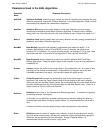
960L Owner’s Maunal Using The Reverb Program
Parameters Used in the 960L Algorithms
5-9
Parameter
Name
AmbPreD
AmbSize
AmbLvl
BassMult
BassXOV
Contour
CtrRvb
Definition
Diffus
Parameter Description
Ambience PreDelay (Ambience only) controls the time of a predelay that precedes the early
reflection (ambience) component of Stereo Ambience. In the same algorithm, RvbDly controls
the predelay that precedes the reverberation component.
Ambience Size scales all the delay elements of the early reflection and early energy
components of Ambience and Ambient Chamber algorithms. To keep the early reflection
energy within the 15ms-50ms window, this control should be set no higher than about 6 or 7.
Ambience Level sets the overall level of the early reflection and early energy components of
Ambience and Ambient Chamber algorithms.
Bass Multiply controls the low frequency reverberation time relative to MidRT. If, for
example, Bass Multiply is set to 2X and MidRT is set to 2 seconds, the effective low
frequency RT is 4 seconds. For natural sounding results, use settings of 1.5X or less. Note
that values less than 1.0X produce a low frequency RT that is shorter than MidRT.
Bass Crossover sets the frequency at which the transition between MidRT and Bass
Multiply takes place. Except for special effects, there is seldom a need for this parameter to
exceed 500 Hz.
Contour controls the profile of the energy decay in the reverberation tail. At a value of zero,
this decay will be smooth and featureless. Large positive and negative values will add
noticeable bumpiness of the decay. Use non-zero values with great caution.
Center Reverb Level controls the reverberation level of the Center output in surround
algorithms. This allows the Center Reverb Level to be set relative to both early reflection
levels and the Front and Rear Reverb Levels. We recommend that the center reverb level be
set about 4.5dB lower than the Front Reverb Level and the Rear Reverb Level. RvbLvl is a
master control for CtrRvb, FrRvb and RearRvb.
Definition is found only in the Chamber and Reverse algorithms. It models the irregularity
of reflecting surfaces in the space.
In Chamber, turning Definition up makes reflections more discrete, making the reflecting
surfaces seem less diffuse. Except for special effects, it is recommended that this be set to
zero.
In Reverse, Definition controls density buildup; lower values produce more density.
Diffusion models the effect of irregular wall surfaces in a room by changing echo density.
Very low values produce sharp, discrete early reflections. Higher values produce groups of
reflections that are smoother but less articulated. Except for special effects, it is
recommended that this control be set to a high value.


















